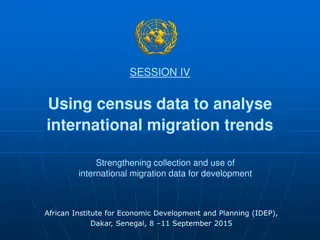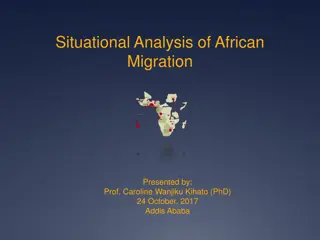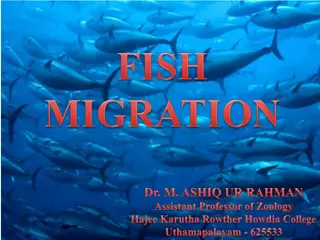Cloud Migration
Cloud migration strategy involves careful planning, analysis, and execution to move applications, data, and infrastructure from on-premises environments to the cloud. Dr. Jay Sarraf from the School of Computer Engineering at KIIT Deemed to be University provides insights on planning, choosing the right cloud environment, migrating apps and data, and validating post-move success. Different strategies like rehosting (lift and shift) are explained, highlighting the importance of a seamless transition while minimizing disruptions to business operations.
Download Presentation

Please find below an Image/Link to download the presentation.
The content on the website is provided AS IS for your information and personal use only. It may not be sold, licensed, or shared on other websites without obtaining consent from the author.If you encounter any issues during the download, it is possible that the publisher has removed the file from their server.
You are allowed to download the files provided on this website for personal or commercial use, subject to the condition that they are used lawfully. All files are the property of their respective owners.
The content on the website is provided AS IS for your information and personal use only. It may not be sold, licensed, or shared on other websites without obtaining consent from the author.
E N D
Presentation Transcript
Cloud Migration Understanding Cloud Migration Strategies Dr. Jay Sarraf School of Computer Engineering KIIT Deemed to be University
Introduction What is Cloud Migration? Cloud migration strategy refers to the step-by-step plan and approach that organizations adopt to move their applications, data, and infrastructure from on-premises environments to the cloud. It involves careful planning, analysis, and execution to ensure a seamless transition while minimizing disruptions to business operations. Cloud Computing Cloud Cloud Migration On Premise Dr. Jay Sarraf, School of Computer Engineering, KIIT Deemed to be University
Cloud Migration Process Step 1 Planning Your Migration Explain the importance of planning before starting the migration process. Highlight the need to be clear on reasons for the move and select the best strategy to support those reasons. Discuss the significance of assessing the current environment and calculating cloud server requirements. Mention the value of using an application performance management (APM) solution for real-time visibility and expert guidance. Cloud Computing Step 2 Choosing Your Cloud Environment Discuss the decision-making process for selecting a cloud model (public, hybrid, private, or multicloud). Highlight the importance of aligning the chosen cloud environment with current and future needs. Mention the need for the APM solution to extend to the chosen cloud provider(s). Cloud Migration Dr. Jay Sarraf, School of Computer Engineering, KIIT Deemed to be University
Cloud Migration Process Step 3 Migrating Your Apps and Data Explain the significance of accurate planning for a smooth migration process. Address cloud security concerns and the need to comply with security policies. Emphasize the importance of data backup and recovery planning. Highlight the value of using APM to baseline premigration performance. Cloud Computing Step 4 Validating Post-Move Success Emphasize the importance of validating the success of a cloud migration. Introduce AppDynamics Business iQ as a solution to prove the benefits of cloud migration. Mention the ability to compare pre- and post-move application performance from both technical and business perspectives. Highlight the value of conducting tests in a low-risk environment. Cloud Migration Dr. Jay Sarraf, School of Computer Engineering, KIIT Deemed to be University
Cloud Migration Strategies 1 Rehosting (Lift and Shift) Rehosting, also known as lift and shift, involves migrating your existing applications to the cloud infrastructure without making significant changes to the underlying architecture. This strategy is ideal for organizations looking for a quick and straightforward migration process. It involves replicating the existing infrastructure and systems in the cloud, eliminating the need for substantial modifications. Cloud Computing Rehosting offers the advantage of minimal disruption and a faster migration timeline. However, it may not take full advantage of the cloud's scalability and cost-saving features. Cloud Migration Dr. Jay Sarraf, School of Computer Engineering, KIIT Deemed to be University
Cloud Migration Strategies 2 Refactoring (Re-Platforming) Refactoring, or re-platforming, involves making slight modifications to your applications or infrastructure to optimize them for the cloud environment. This strategy aims to take advantage of cloud-native features and services while retaining the core functionalities of your existing systems. Cloud Computing By refactoring, you can leverage the scalability, elasticity, and managed services offered by cloud providers. This strategy requires some level of code and architecture changes but offers a better balance between speed and optimization. Cloud Migration Dr. Jay Sarraf, School of Computer Engineering, KIIT Deemed to be University
Cloud Migration Strategies 3 Rebuilding (Full Rewrite) Rebuilding, also known as full rewrite, is the most comprehensive cloud migration strategy. It involves redesigning and rebuilding your applications from scratch, using cloud-native technologies and best practices. This approach allows you to fully leverage the benefits of the cloud, including scalability, performance, and cost-efficiency. Cloud Computing Rebuilding provides an opportunity to modernize your applications and eliminate any technical debt. However, it is the most time-consuming and resource-intensive strategy, requiring careful planning and execution. Cloud Migration Dr. Jay Sarraf, School of Computer Engineering, KIIT Deemed to be University
Cloud Migration Strategies 4 Retiring and Replacing Retiring and replacing involves identifying legacy systems or applications that are no longer necessary or suitable for the cloud environment. In this strategy, you retire outdated or redundant systems and replace them with cloud-native alternatives or newer applications that better align with your business goals. Cloud Computing Retiring and replacing allows you to streamline your infrastructure, reduce maintenance costs, and take advantage of modern technologies. It requires a thorough evaluation of your existing systems and careful planning for the replacement process. Cloud Migration Dr. Jay Sarraf, School of Computer Engineering, KIIT Deemed to be University
Selecting the Right Strategy When choosing a cloud migration strategy, several factors need to be considered. These include: Business Goals: Align the chosen strategy with your organization's overall objectives and future growth plans. Cloud Computing Application Complexity: Evaluate the complexity of your applications and determine if they can be easily migrated or require significant modifications. Time and Resources: Assess the available time, budget, and resources for the migration project. Some strategies require more time and resources than others. Scalability and Performance Requirements: Consider the scalability and performance demands of your applications to determine which strategy can meet those requirements effectively. Cloud Migration By carefully evaluating these factors, you can select the most suitable strategy for your organization's cloud migration journey. Dr. Jay Sarraf, School of Computer Engineering, KIIT Deemed to be University
Benefits of Cloud Migration Cloud migration offers numerous benefits to organizations, including: Scalability: Cloud environments allow businesses to scale their resources up or down based on demand, ensuring optimal performance and cost-efficiency. Cloud Computing Cost Savings: Migrating to the cloud eliminates the need for maintaining and upgrading on-premises infrastructure, resulting in significant cost savings. Agility and Flexibility: Cloud platforms offer agility and flexibility, enabling organizations to quickly adapt to changing market conditions and rapidly deploy new services or applications. Cloud Migration Enhanced Collaboration: Cloud environments provide centralized platforms for collaboration, enabling teams to work together seamlessly and improve productivity. Dr. Jay Sarraf, School of Computer Engineering, KIIT Deemed to be University
Challenges of Cloud Migration While the benefits of cloud migration are compelling, businesses should be aware of the challenges they might encounter during the process. Some common challenges include: Data Security: Ensuring the security and protection of data during migration is critical. Organizations must implement robust security measures and adhere to compliance regulations. Cloud Computing Application Compatibility: Compatibility issues may arise when migrating applications to the cloud. Certain applications may require modifications to function optimally in the new environment. Legacy Systems Integration: Integrating legacy systems with cloud infrastructure can be complex. Organizations need to plan and execute the integration carefully to maintain seamless operations. Cloud Migration Dr. Jay Sarraf, School of Computer Engineering, KIIT Deemed to be University
Conclusion Cloud migration is a strategic process that offers numerous benefits, including scalability, cost savings, improved security, and enhanced collaboration. Organizations choose cloud migration to optimize their infrastructure, increase flexibility, and leverage cloud-native services. Cloud Computing Cloud migration strategies include rehosting (lift and shift), refactoring (re- platforming), rebuilding (full rewrite), and retiring/replacing. It is essential to align the chosen strategy with the organization's goals, evaluate application complexity, and consider available resources and scalability requirements. Cloud Migration Thorough planning, testing, and resourcing are crucial for a successful cloud migration project. Cloud migration presents an opportunity to modernize applications, streamline operations, and achieve long-term business goals. Dr. Jay Sarraf, School of Computer Engineering, KIIT Deemed to be University
Remember Understand the benefits of cloud migration, including scalability, cost savings, security, and collaboration. Evaluate the challenges of cloud migration, such as downtime, data loss, resource management, and interoperability. Cloud Computing Consider different cloud migration strategies: rehosting, refactoring, rebuilding, and retiring/replacing. Align the chosen strategy with your organization's goals and future growth plans. Plan for downtime and backup strategies to minimize disruptions during the migration process. Cloud Migration Ensure proper communication and collaboration between existing applications and the new cloud environment. Regularly evaluate and validate the success of your cloud migration by comparing pre- and post-move application performance. Dr. Jay Sarraf, School of Computer Engineering, KIIT Deemed to be University























